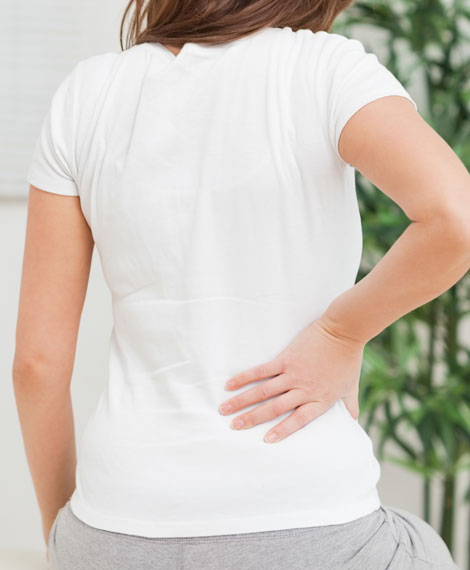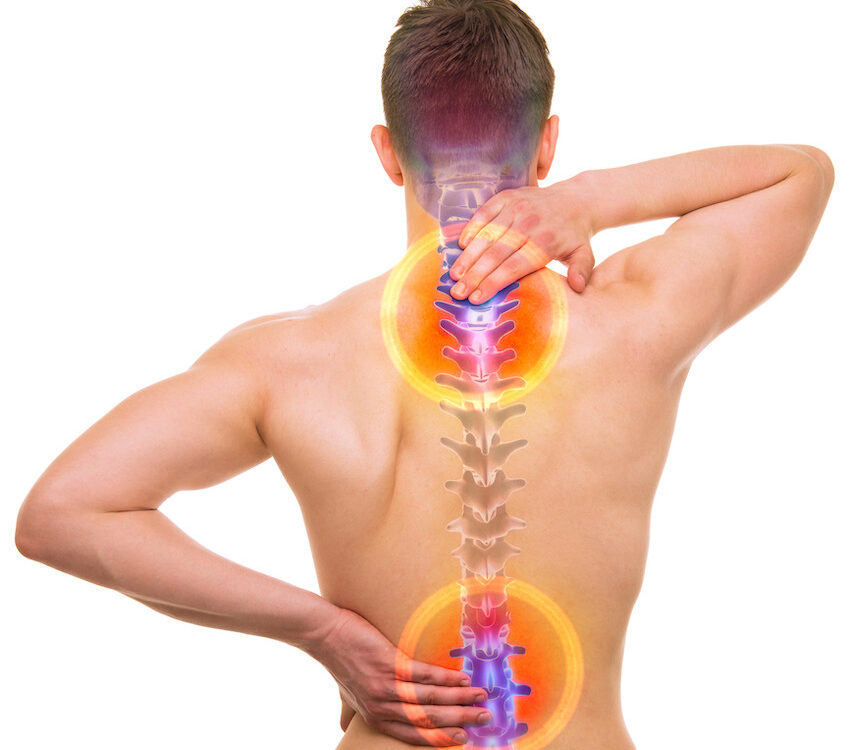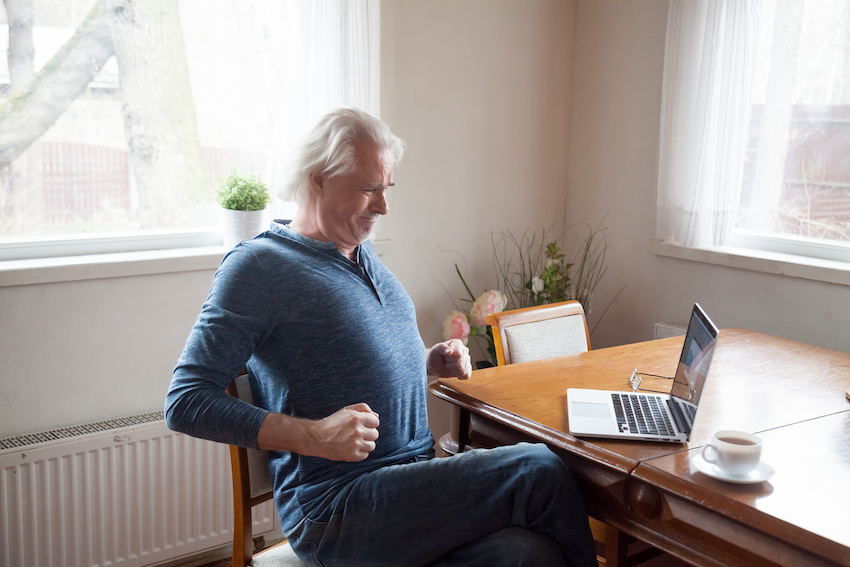
Now Offering Minimally Invasive Treatment of Spinal Stenosis to Prevent Fusion Surgery
While there are differences in how stenosis can affect the anatomy, all forms of stenosis are typically referred to as simply spinal stenosis. In general, there are three main types of spinal stenosis:
1. Foraminal Stenosis
Foraminal stenosis is most common type of lumbar spinal stenosis, and may also be referred to as lateral spinal stenosis. As the nerve root is about to leave the canal through a side hole in the back of the spine, called the neuro-foramen, a bone spur (osteophyte) that has already developed from a degenerating disc, or an arthritic facet joint, can press on that nerve root.
With this type of stenosis, the emerging nerve root is trapped (for example, the L4 to S1 individual spine nerves that form the sciatic nerve). This type of spinal stenosis can easily be visualized as a pinching of the nerves.To understand more about what a foramen is, or to learn about spine anatomy please click on this video:
http://www.spine-health.com/video/spine-anatomy-interactive-video
2. Central Stenosis
Narrowing of the central canal (called central stenosis) in the lumbar (low back) area can compress the thecal sac. This narrowing can cause pressure on the nerve bundle at the end of the spinal cord (cauda equina), or the individual nerves within the thecal sac.
3. Far Lateral Stenosis
The individual nerves exit from the center of the spinal canal out hole in the back of the spine called the neuro-foramen. Beyond the neuro-foramen, there can also be narrowing secondary to the development of bone spurs from the facet joints, bulging discs, herniated discs, and ligamentum hypertrophy. This narrowing of the area lateral, or to the side of the neuro-foramen is called far lateral stenosis. There is often a combination of foraminal and far lateral stenosis. If spinal stenosis surgery is to be performed, the different locations and types of compression are important to identify in order to guide the surgeon. With the proper imaging studies, the surgeon will plan a focused approach to the areas of spinal stenosis. Subtle differences between central, foraminal, and far lateral locations need to be defined, and deliberate planning is necessary to address all the potential areas.
Common Spinal Stenosis Symptoms
Overall, spinal stenosis symptoms are often characterized as:
- Developing slowly over time, or slow onset.
- Coming and going, as opposed to continuous pain.
- Occurring during certain activities (such as walking for lumbar stenosis, or biking while holding the head upright) and/or positions (such as standing upright for lumbar stenosis).
- Feeling relieved by rest (sitting or lying down) and/or any flexed forward position.
Lumbar Stenosis Symptoms
To watch a video about lumbar spinal stenosis, click here:
http://www.spine-health.com/video/lumbar-spinal-stenosis-video
When stenosis has developed in the lower back (lumbar spine), leg pain with walking may develop. Leg pain with walking is medically known as claudication, and it can be caused by either arterial circulatory insufficiency (vascular claudication) or from spinal stenosis (neurogenic or pseudo-claudication). Leg pain from either condition will go away with rest, but with spinal stenosis the patient usually has to sit down for a few minutes to ease the leg and often low back pain, whereas leg pain from vascular claudication will go away if the patient simply stops walking.
For lumbar stenosis, flexing forward or sitting will open up the spinal canal by stretching the ligamentum flavum and will relieve the leg pain and other symptoms, but the symptoms will recur if the patient gets back into an upright posture. Numbness and tingling can accompany the pain, but true weakness is a rare symptom of spinal stenosis.
Cervical Stenosis Symptoms
When stenosis has developed in the neck (cervical spine), nerve pain may develop in the upper extremities. As the nerves are compressed, pain signals travel along the length of them into the upper extremities. Numbness and tingling can accompany the pain, especially in the hands, but true weakness is a rare symptom of spinal stenosis.
To watch a video about cervical spinal stenosis, click here:
http://www.spine-health.com/video/cervical-spinal-stenosis-video
Spinal Stenosis Diagnosis
Diagnostic imaging studies for patients with any type of spinal stenosis include either an MRI scan or a CT scan with myelogram (using an X-ray dye in the spinal sac fluid), and sometimes both. Plain CT scans can better identify bony causes of spinal stenosis, but cannot give the same detail for soft tissue causes of stenosis such as disc bulges, disc herniations, and ligament hypertrophy. Due to this changing compression, spinal stenosis symptoms vary from time to time and the physical examination generally will not show any neurological deficits or motor weakness. Certain activities and body position may trigger the symptoms.
In some medical centers, upright MRIs, flexion extension MRIs, and spine load-bearing MRIs have been used to identify the dynamic changes on the spine, and the canal dimensions.
Foraminal stenosis can be pinpointed not only by the CT and MRI scans, but by injecting the suspicious nerve with a small volume of local anesthetic and sometimes with a corticosteroid. This procedure is called a selective nerve root block (or a Transforaminal Epidural Steroid Injection).
To watch a video about Transforaminal Epidural Steroid Injections, click below:
http://www.spine-health.com/video/cervical-selective-nerve-root-block-video
After the injection a remission of the patient’s symptoms along with true temporary weakness of the limb is clinically diagnostic and can help the surgeon determine the source of symptoms.
Treatment for Stenosis
A variety of pain management techniques may be incorporated to effectively ease the pain and inflammation for lumbar spinal stenosis.
- Ice Treatments
- Icing the lower back after exercise is a common treatment of spinal stenosis of the spine. The goal of ice therapy is to numb the affected area and achieve temporary pain relief. A frozen bag of peas works well for this purpose. Simply apply the cold pack for about 10 minutes at a time. If there is a lack of sensation in the lower back area, do not use ice or heat to avoid damaging the skin.
- Heat Therapy
- Heating over tight muscles in the back is often an effective way to achieve relief from spinal stenosis pain, as heating relaxes the muscles. Heating the affected area stimulates blood flow, which promotes and accelerates the healing process.
Pain Medications for Spinal Stenosis
Since inflammation is a common component of spinal stenosis, patients may achieve pain relief from NSAIDs (non-steroidal anti-inflammatory drugs) such as aspirin or ibuprofin, e.g., Advil. A general pain reliever such as acetaminophen (e.g., Tylenol) may also be helpful.
If symptoms are severe, progressive or interfering with daily life, it is a good idea to have a discussion with the doctor to review different stenosis treatment options. The doctor may prescribe prescription medications, physical therapy and exercises, injections (including possible epidural steroid injections), and if severe enough, stenosis surgery.
Interventional Treatments
- Epidural Steroid Injections (Interlaminar vs Transforaminal)
- Spinal Cord Stimulation (SCS)
- Percutaneous Decompressive Laminotomy
REFERENCES:




